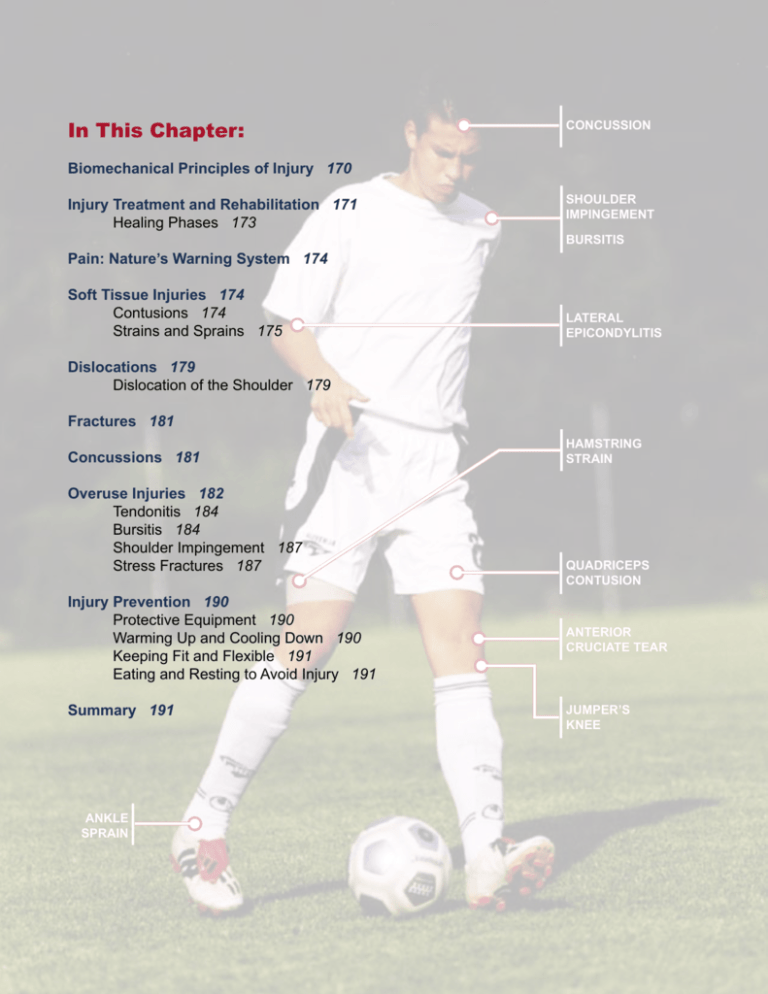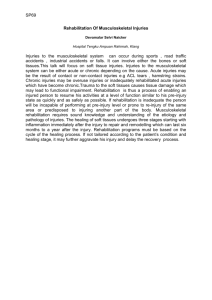In This Chapter:
advertisement

In This Chapter: CONCUSSION Biomechanical Principles of Injury 170 Injury Treatment and Rehabilitation 171 Healing Phases 173 Pain: Nature’s Warning System 174 Soft Tissue Injuries 174 Contusions 174 Strains and Sprains 175 SHOULDER IMPINGEMENT BURSITIS LATERAL EPICONDYLITIS Dislocations 179 Dislocation of the Shoulder 179 Fractures 181 Concussions 181 Overuse Injuries 182 Tendonitis 184 Bursitis 184 Shoulder Impingement 187 Stress Fractures 187 Injury Prevention 190 Protective Equipment 190 Warming Up and Cooling Down 190 Keeping Fit and Flexible 191 Eating and Resting to Avoid Injury 191 Summary 191 ANKLE SPRAIN HAMSTRING STRAIN QUADRICEPS CONTUSION ANTERIOR CRUCIATE TEAR JUMPER’S KNEE Let’s explore sports injuries.... CHAPTER 8 Out of Harm’s Way: Sports Injuries After completing this chapter you should be able to: n identify the factors associated with injury prevention; n describe the common musculoskeletal injuries; n demonstrate an understanding of the implications of various chronic and acute injuries and how to treat them. 169 170 The human body is designed to perform a wide variety of simple and complex movements and skills. Clearly, this ability relies on all its parts working together in harmony. An injury to one body part can disrupt the harmony of the entire body. Fortunately, many injuries are preventable. With more people participating in sports and physical activity for health, fitness, and fun, avoiding injury is a notable concern. Many people ignore the warnings and risks that accompany certain activities, believing that nothing can possibly happen to them. Even the most careful physically active person can experience a mishap, but following some specific guidelines can greatly decrease your risk of sustaining an injury. Whether you make a concerted effort to improve your skills and technique when exercising, recognize the Foundations of Exercise Science hazards that exist around you, perform proper conditioning exercises, or demand safe and quality equipment, you can enjoy an enhanced level of safety and confidence in your physical pursuits. You must take responsibility for your own actions by making appropriate decisions that reflect your safety and personal health (Figure 8.1). Despite our efforts to take all of the necessary precautions, all dangers can never be completely eliminated; accidents do happen and injuries do occur. While most injuries are minor and not life threatening, knowing what to do if an injury occurs helps you deal with the situation quickly and correctly. An injury that is not cared for properly can easily escalate into a chronic problem that may plague your efforts to lead an active life. Biomechanical Principles of Injury The human body is made up of tissues or groups of cells that work together to perform a particular function. The four basic types of tissue are epithelial (e.g., skin), muscle, connective (e.g., tendons, bones, and ligaments), and nervous. Each type of tissue possesses unique mechanical characteristics. For example, bones are strong and stiff, whereas tendons are flexible so that joints can be mobile. To best understand the biomechanical characteristics of tissue, we examine its behavior under physical load (see box Forces Acting on Tissue). Under load, a tissue experiences deformation. This change in shape phenomenon can be visualized in the load–deformation curve in Figure 8.2. ? Did You Know? Figure 8.1 Staying fit and active throughout your life requires attention to conditioning, healthy lifestyle choices, and safety. When developing a prosthesis for human parts, such as a hip joint, biomechanical engineers ensure that the prosthesis can handle loads as well as or better than the human tissue it will be replacing. Studying Human Movement and Health Characteristics of the Load– Deformation Curve 171 High Ultimate Yield Point C Yield-level Point B • Loads occurring in the elastic region do not cause • Permanent deformation will occur if loads exceed the yield-level point. Load permanent damage. Plastic Region • The area under the entire curve represents the strength of the material in terms of stored energy. Elastic Region • The slope of the curve in the elastic region indicates the stiffness of the material. Stiffness is the resistance to deformation, where the greater the slope of the curve, the greater the stiffness of the structure. Low A Small Deformation Large Figure 8.2 Load–deformation curve of a bone.. The A to B segment of the curve represents the elastic region of the tissue structure. Elasticity is the capacity of a tissue to return to its original shape after a load is removed. For example, when you push your finger into your thigh, the skin and the muscle underneath your finger become depressed. When pressure is removed, the tissues return to their original shape. Point B on the curve (yield-level point) signals the elastic limit of the tissue, where the plastic region begins. In this region, increased loads cause permanent tissue deformation, resulting in micro-failure or injury to the tissue. Sprains and strains are good examples of such injuries. If the load continues to increase to the ultimate yield point (point C on the curve), ultimate failure of the tissue eventually occurs: a bone fracture or torn ligament. At this point the tissue becomes completely unresponsive to loads. Injury Treatment and Rehabilitation Treatment and rehabilitation are two directly linked aspects of recovery. During treatment, a patient receives care by a health care professional. Tissue Responses to Training Human tissue responds to training loads or stresses by becoming stronger. When training loads are at or near a tissue’s yield-level point (Figure 8.2, point B), cells may divide to make new cells or to make proteins such as actin, myosin, collagen, or elastin to improve the mechanical properties of the tissue under stress. This muscle response is called the positive training effect. Training overloads may cause microscopic injuries in various muscle regions, leading to sore muscles. In these situations, the muscle structures are temporarily weakened. It is important to let them recover before another workout. Research has shown that optimal training occurs at a level of tissue stress just below the yield-level point. Early and correct treatment promotes the healing process and improves the quality of the injured tissue(s), allowing the person to return to activity more quickly. Rehabilitation involves a therapist’s physical restoration of the injured tissue along with the patient’s active participation by following prescribed rehabilitation guidelines on his or her own. Although an individualized rehabilitation 172 Foundations of Exercise Science Forces Acting on Tissue Tissue is exposed to a variety of physical stresses during physical activity. These stresses are forces and moments acting as directional loads that generate tension (pulling), compression (squeezing), bending, shear, or torsion. Tension Tension Compression Shear Compression Bending Torsion Studying Human Movement and Health 173 program should be created for each athlete, knowledge of general guidelines for early treatment and rehabilitation can be useful for dealing with acute injuries in particular. Some of these guidelines will be presented in this chapter. Follow the PRICE rule! When dealing with an injury, follow these simple steps: Healing Phases P The healing process begins immediately after injury and consists of three overlapping phases: the inflammatory response phase, the fibroblastic repair phase, and the maturation–remodeling phase (Figure 8.3). Inflammatory Response Phase The inflammatory response phase sets the stage for tissue repair. Inflammation begins at the time of injury, or shortly after, and may last from two to four days. The injured area may show signs of redness, swelling, pain, increased temperature, and loss of function. To allow healing to begin, the injury must be protected and rested. Cryotherapy (ice or cold water immersion for 15 to 20 minutes at a time) limits the amount of swelling and decreases bleeding, pain, and muscle spasms. Compression is applied over the ice, usually in the form of an elastic bandage. During cold water immersion, a compression bandage can be wrapped around the injured area. Finally, the area is elevated above the level of the heart to encourage the return of venous blood to the heart, thereby helping to decrease acute swelling and bleeding. Protect R Rest I C Ice Compress E Elevate Fibroblastic Repair Phase The fibroblastic repair phase leads to scar formation and repair of the injured tissue. It begins within a few hours of injury and may last as long as four to six weeks. A delicate connective tissue called granulation tissue forms to fill the gaps in the injured area. Fibroblasts produce collagen fibers, which are deposited randomly throughout the forming scar. In this second phase, many of the signs and symptoms seen in the inflammatory response subside. During the fibroblastic repair phase, it is important to introduce controlled rehab-specific exercises that are designed to restore normal range of motion and strength to the injured tissue, as well as stressing the tissue to promote optimal tissue response (see box Tissue Responses to Training). Manual massage therapy and ultrasound help break down scar tissue. Protective taping or a brace is often used during this phase of rehabilitation. Inflammatory Response Phase Fibroblastic Repair Phase Maturation– Remodeling Phase 2 – 4 days hours – 6 weeks 3 weeks – years Figure 8.3 The three phases of the healing process..






